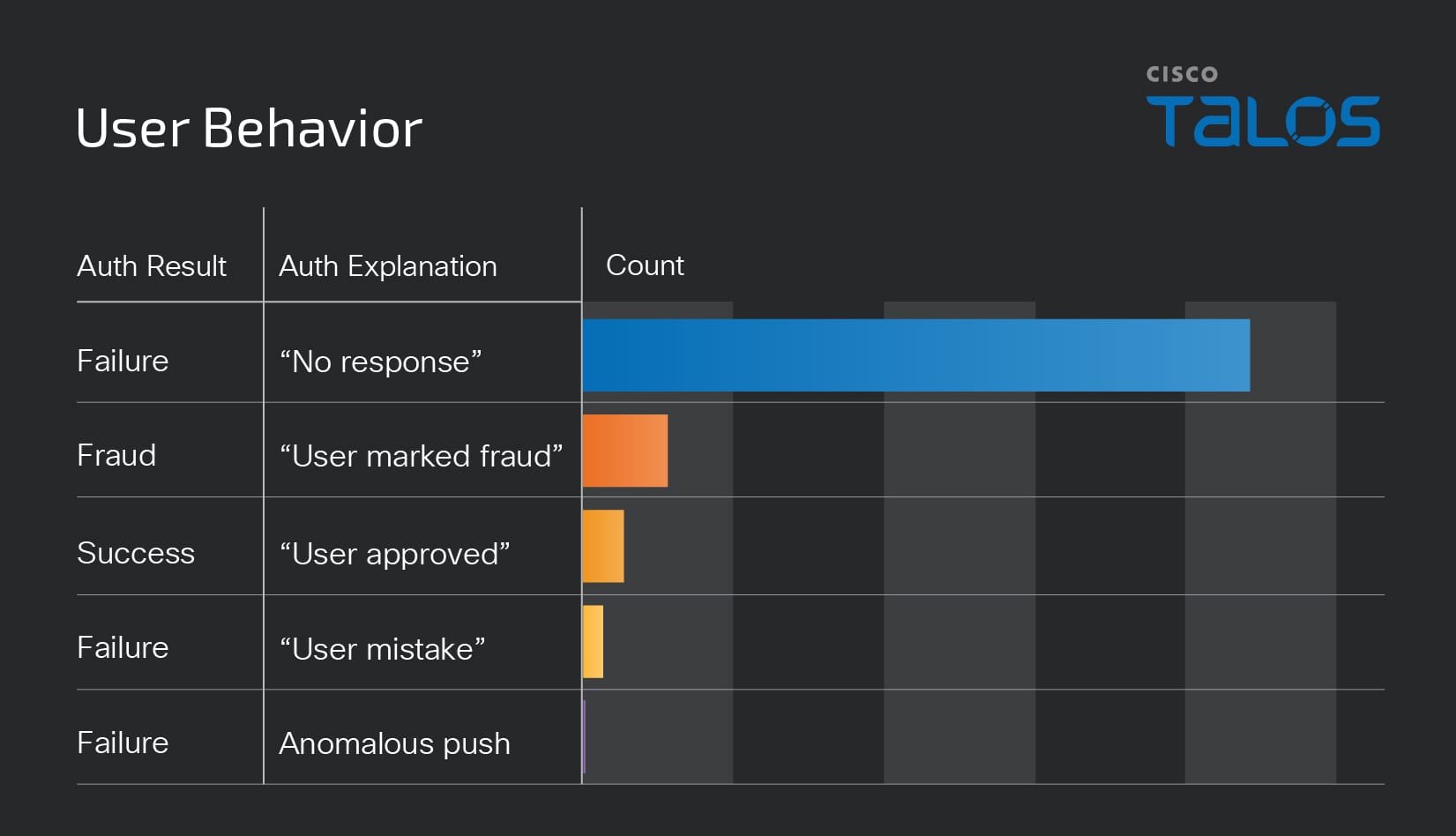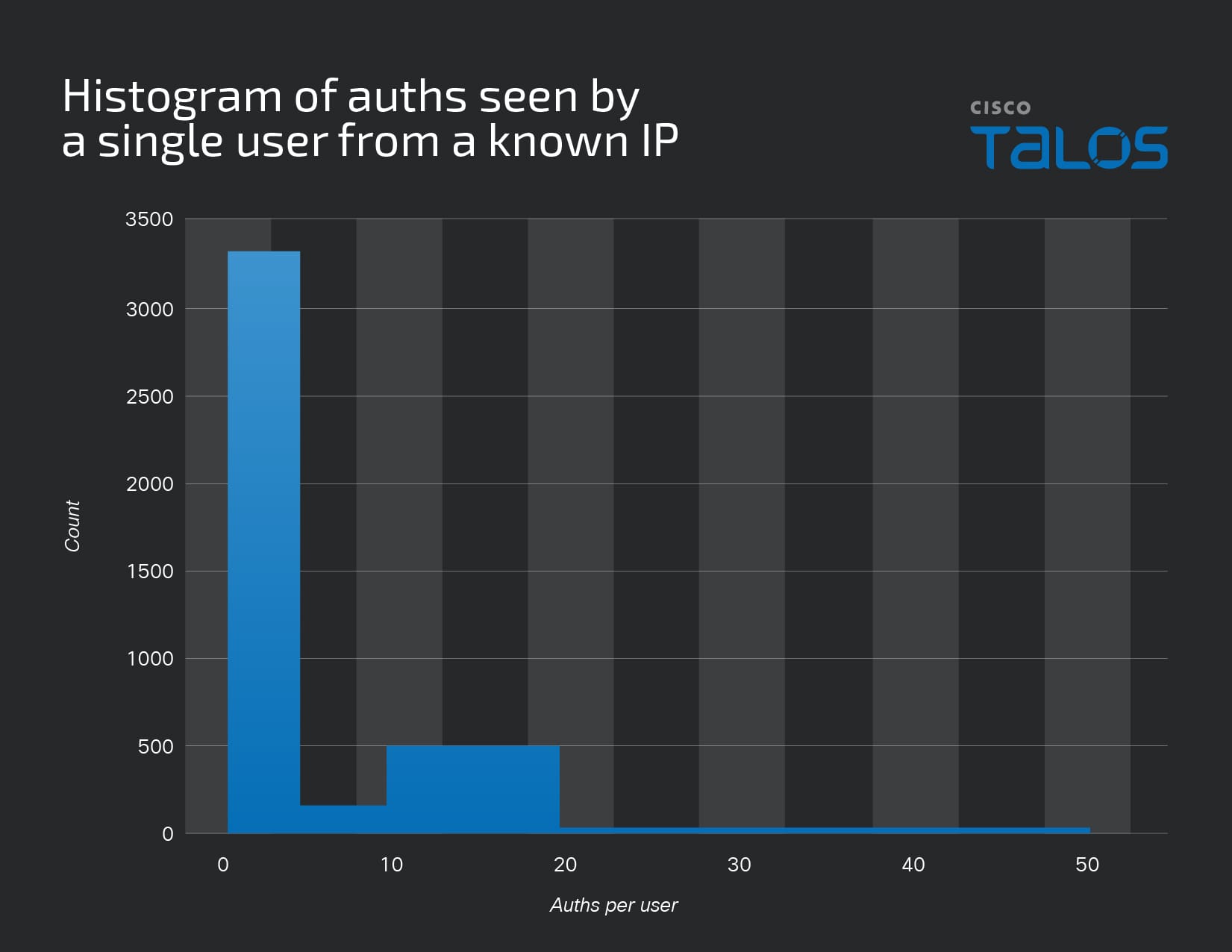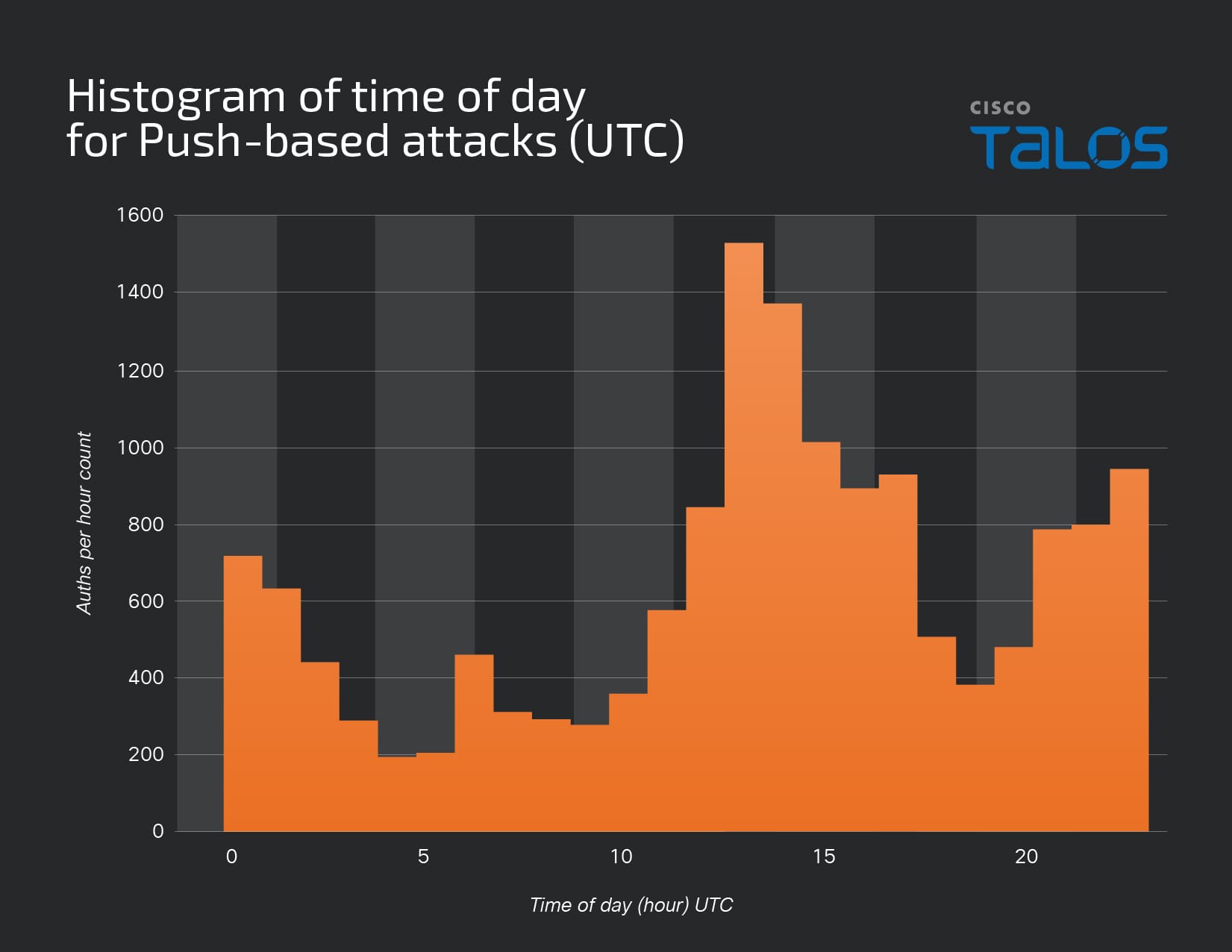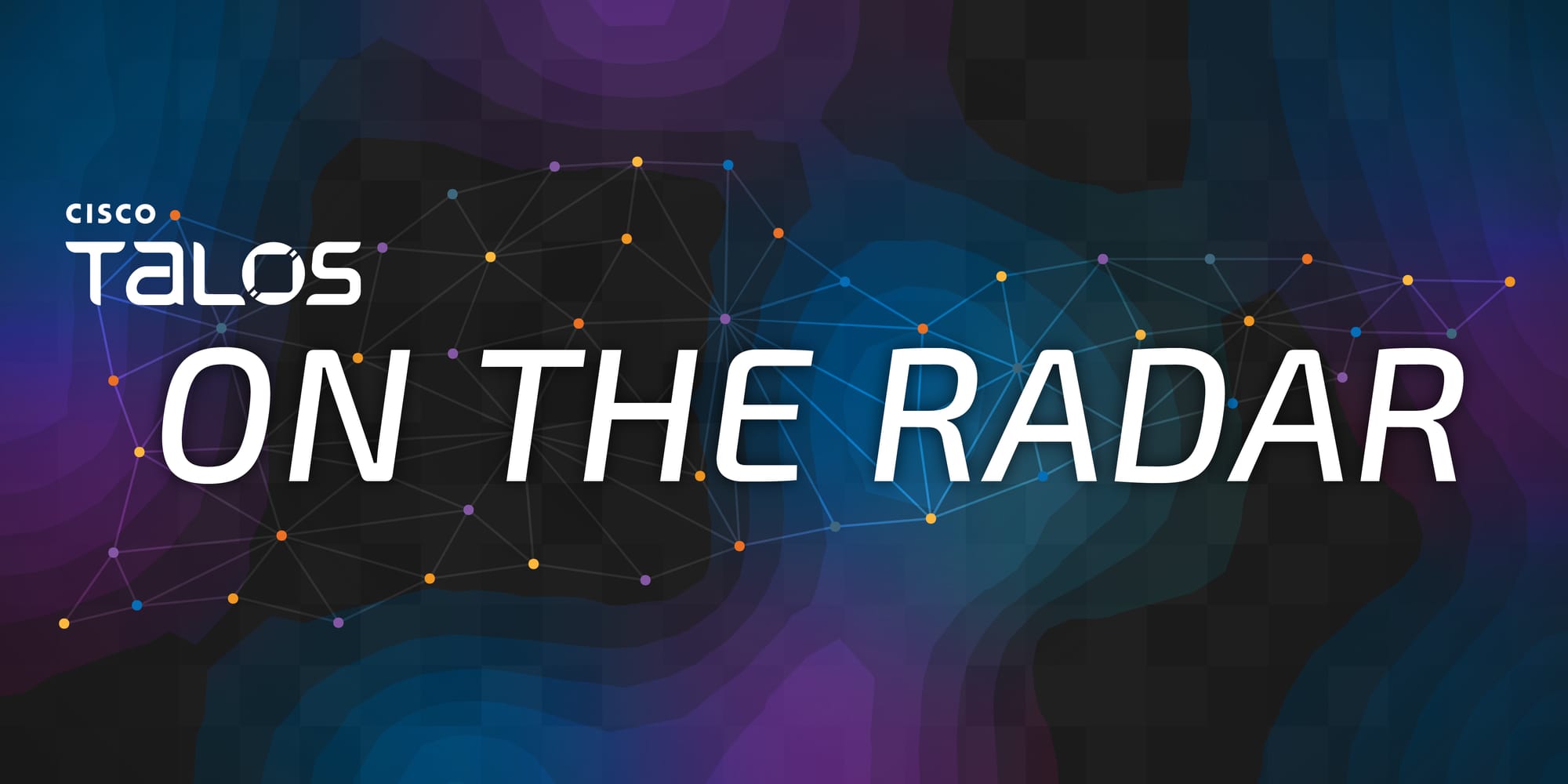In the latest Cisco Talos Incident Response Quarterly Trends report, instances related to multi-factor authentication (MFA) were involved in nearly half of all security incidents that our team responded to in the first quarter of 2024.
In 25% of engagements, the underlying cause was users accepting fraudulent MFA push notifications that originated from an attacker. In 21% of engagements, the underlying cause for the incident was a lack of proper implementation of MFA.
I was curious to see what some of the reasons might be as to why these two issues were the top security weaknesses outlined in the report. To do so, I’ll explore (with the help of Cisco Duo’s AI and Security Research team and their push-based attack dataset) the parameters that attackers are using to send their fraudulent MFA attempts, including:
- The percentage of MFA push spray attacks accepted by the user.
- How many push requests a victim user was sent.
- Peak times of occurrence.
- Time between successive push attempts.
I’ll also explore the current methods that attackers are using to bypass MFA or social engineer it to gain access.
It’s worth noting that there has been a lot of progress made by defenders over the past few years regarding implementing MFA within their organizations. MFA has significantly contributed to reducing the effectiveness of classic credential stuffing and password spraying attacks by adding an extra layer of authentication. This is a large reason as to why attackers are targeting MFA so heavily – it’s a significant barrier they need to get around to achieve their goals.
But as with any form of defense, MFA isn’t a silver bullet. The issues we’re seeing now are mostly down to attacker creativity to try and bypass MFA, and overall poor implementation of the solution (for example, not installing it on public-facing applications or EOL software). There are also some legitimate cases where MFA cannot be implemented by an organization, in which case, a robust access policy must be put in place.
The data behind push spray attacks
The most common type of MFA bypass attempts we see are MFA push attacks, where the attacker has gained access to a user’s password and repeatedly sends push notifications to their MFA-enabled device, hoping they will accept.
We asked Cisco Duo’s AI and Security Research team to provide some metrics for push-based attacks from their attack dataset, which contains 15,000 catalogued push-based attacks from June 2023 - May 2024.
In the first metric (the overall response to fraudulent pushes) we learn that most push-based attacks aren’t successful i.e., they are ignored or reported. Five percent of sent push attacks were accepted by users.

However, of that 5%, it didn’t take many attempts to persuade the user to accept the push. Most users who accepted fraudulent pushes were sent between one and five requests, while a very small number were “bombarded” with 20 - 50 requests.

The team also looked at the times of day when fraudulent push attempts were sent. The majority were sent between 10:00 UTC and 16:00, which is slightly ahead of U.S working hours. This indicates that attackers are sending push notifications as people are logging on in the morning, or during actual work hours – presumably hoping that the notifications are in context of their usual working day, and therefore less likely to be flagged.

There is a large peak between 8 and 9 a.m. (presumably when most people are authenticating for the day). The small peak in the early evening is less clear cut, but one potential reason is that people may be on their phones catching up on news or social media, and may be more susceptible to an accidental push acceptance.
Most authentications within a single push attack (sent from the same classified IP) occurred within 60 seconds of each other. As authentications timeout after 60 seconds, the most common “failure” reason was “No response.”
Rather than a “spray-and-pray” approach, this data appears to indicate that attackers are being more targeted in their approach by sending a small number of push notifications to users within a certain period. If they don’t respond, they move onto the next user to try and target as many users as possible within the peak time of 8 – 9 a.m.
Different examples of MFA bypass attempts
As well as push-based spray attacks, recently we have seen several instances where attackers have got a bit creative in their MFA bypass attempts.
In speaking to several members of our Cisco Talos Incident Response team, here are some of the MFA bypass methods that they have seen used in security incidents, beyond the “traditional” MFA push-spray attacks:
- Stolen authentication tokens from employees. Attackers then replay session tokens with the MFA check completed (giving the attackers a trusted user identity to move laterally across the network).
- Social engineering the IT department to add new MFA enabled devices using the attacker’s device.
- Compromising a company contractor, and then changing their phone number so they can access MFA on their own device.
- Compromising a single endpoint, escalating their privileges to admin level, and then logging into the MFA software to deactivate it.
- Compromising an employee (otherwise known as an insider attack) to click “allow” on an MFA push that originated from an attacker.
The attacks outlined above don’t solely rely on MFA weaknesses – social engineering, moving laterally across the network, and creating admin access involves several steps where red flags can be spotted or ultimately prevented. Therefore, taking a holistic view of how an attacker might use MFA or social engineer their access to it is important.
New MFA attack developments
As the commercialization of cybercrime continues to increase with more attacks becoming available “as a service,” it’s worth paying attention to phishing-as-a-service kits that offer an element of MFA bypass as part of the tool.
One such platform is the Tycoon 2FA phishing-as-a-service which relies on the attacker-in-the-middle (AiTM) technique. This isn’t anything new – the technique involves an attacker server (also known as reverse proxy server) hosting a phishing web page, intercepting victims’ inputs, and relaying them to the legitimate service.
The tool has now incorporated the prompt of an MFA request. If the user accepts this, the server in the middle captures the session cookies. Stolen cookies then allow attackers to replay a session and therefore bypass the MFA, even if credentials have been changed in between.
Cat and mouse
These push spray attacks and MFA bypass attempts are simply an evolution of cybersecurity defense. It’s the cat-and-mouse game that persists whenever defenders introduce new technology.
When defenders introduced passwords, attackers introduced password-cracking methodology through rainbow tables, tools like Hashcat and GPU cards. Defenders countered this by introducing account lockout features.
Attackers then introduced password spray attacks to obtain credentials through dedicated tools such as MSOLSpray. After that, defenders brought out MFA to add an additional credential check.
Next, attackers developed dedicated tools like MFASweep to find gaps in the MFA coverage of organizations, looking for IP addresses and ranges, or specific OS platforms that are granted an exception. MFA bypass also contributed to a comeback of social engineering techniques.

With the MFA bypass attempts that are happening in the field, defenders are now exploring various countermeasures. These include WebAuthn and inputting a four-digit number code into MFA tools such as Cisco Duo (requiring the user to input specific text is a stronger MFA method than say SMS). And considering a Zero Trust environment to include contextual factors, such as where and when the device is accessing the system.
Recommendations
From an organizational/ defender point of view, here are some of Talos’ recommendations for implementing MFA:
- Consider implementing number-matching in MFA applications such as Cisco Duo to provide an additional layer of security to prevent users from accepting malicious MFA push notifications.
- Implement MFA on all critical services including all remote access and identity access management (IAM) services. MFA will be the most effective method for the prevention of remote-based compromises. It also prevents lateral movement by requiring all administrative users to provide a second form of authentication.
- Organizations can set up an alert for single-factor authentication to quickly identify potential gaps and changes in the MFA policy (if for example, MFA has been downgraded to a single factor authentication).
- Conduct employee education within the IT department to help prevent social engineering campaigns where attackers request additional MFA enabled devices or accounts.
- Conduct overall employee education about MFA bypass attacks and how they may be targeted. Provide clear reporting lines for alerting the organization to potential MFA attacks.
- In cases where MFA cannot be implemented, for example on some legacy systems that cannot be updated or replaced, work with your MFA vendor to define access policies for those systems and ensure they are separated from the rest of the network.
- Another potential authentication method is a Security key – a hardware device that requires a PIN.
Read the latest Cisco Talos Incident Response Quarterly Trends report to learn more about the current threat trends and tactics.
Read the Cisco Duo Trusted Access Report to examine trends (existing and emerging) in both access management and identity.
